Blackjack has always been a favorite among casino games due to its blend of strategy, chance, and quick gameplay. While luck plays a significant role in determining whether you’ll walk away with winnings, mastering certain techniques and approaches can give you a real edge. Unlike other casino games that rely entirely on chance, blackjack allows you to influence the outcome through informed decisions. In this article, we’ll dive into some expert tips to help you increase your chances of winning at blackjack. From understanding the importance of basic strategy to mastering card counting, these strategies can significantly impact your success at the table.
Mastering Basic Blackjack Strategy: The Foundation of Winning
Learning basic strategy is essential to increase your chances of winning at blackjack. Unlike guessing or going with your gut, the basic strategy is a mathematically tested approach to playing the game. It’s based on probability and tells you the best possible action. This includes knowing when to hit, stand, double down, or split, depending on your hand and the dealer’s upcard.
For instance, a common scenario in blackjack is knowing when to hit or stand. The general rule of thumb is to hit if your hand totals between 12 and 16 and the dealer shows a card between 7 and Ace. This is because the dealer is more likely to get a strong hand, and you must improve your chances. Conversely, you should stand if your hand totals 17 or more and the dealer shows a low card (between 2 and 6). The dealer is more likely to bust in these cases, so it’s often better to play it safe.
Doubling down is another key part of a basic strategy that can enhance your odds. Doubling down means you double your original bet and take only one additional card. This move can be advantageous when your initial hand totals 10 or 11 and the dealer shows a weak card, typically between 2 and 6. In these instances, the likelihood of drawing a card that brings you to 21 or close enough to beat the dealer is higher.
The basic strategy also covers when to split pairs. Splitting can be particularly useful if you receive two cards of the same rank. For example, always split aces and eights because aces give you a higher chance of getting 21 while splitting eights allows you to work with two decent hands instead of one bad 16. However, avoid splitting tens or fives—keeping tens gives you a strong hand of 20, while fives offer better chances of success if you hit or double down.
In short, sticking to a basic strategy significantly reduces the house edge, bringing it down to less than 1%. While it doesn’t guarantee a win every time, it places you in the best position to make informed decisions and manage your losses wisely.
Bankroll Management: How to Play Smart and Stay in the Game
Solid bankroll management is another crucial factor in maximizing your chances of winning at blackjack. You can know all the strategies in the world, but without managing your money wisely, you’ll find yourself out of the game before you even hit a hot streak. Bankroll management ensures you can weather losses and capitalize on winning streaks when they come.
First and foremost, set a budget before you even step into the casino or open your online gaming app. Decide how much you will lose, and stick to that limit. Blackjack is a fast-paced game, and getting carried away is easy, especially when emotions start running high. The key to good bankroll management is discipline—never chase your losses by betting more than you can afford in the hopes of recouping them quickly.
One tried-and-true method is to divide your total bankroll into smaller units. For instance, if you have $500 to spend on blackjack, consider dividing that amount into $50 units. This allows you to make 10 individual bets and ensures you won’t blow through your budget in just a few rounds. Sticking to smaller bets allows you to ride out losing streaks while keeping you in the game long enough to catch a few winning rounds.
It’s also important to adjust your bet size according to the situation. If you’re on a losing streak, don’t increase your bets to recover faster. Instead, lower your bet size until you start winning again. Conversely, if you’re on a winning streak, slightly increasing your bet size can help you take full advantage of the situation. This is known as progressive betting and, when done cautiously, it can increase your profits without putting too much of your bankroll at risk.
Another essential aspect of bankroll management is knowing when to walk away. Many players lose not because they don’t know how to win but because they don’t know when to stop. Set both win and loss limits before you start playing. For instance, decide to walk away if you’ve won $200 or lost $100. Sticking to these limits helps protect your bankroll and ensures you leave the table with some of your winnings intact rather than risking it all.
Card Counting: Is It Still a Viable Strategy?
Card counting has long been romanticized in movies and books as a surefire way to beat the house at blackjack. While it’s not as easy as it seems and doesn’t guarantee success, card counting can still be an effective tool for skilled players. The technique involves tracking the high and low cards remaining in the deck to determine whether the upcoming cards will likely favor the player or the dealer.
The basic premise of card counting is that low cards (2-6) are more favorable to the dealer, while high cards (10, Jack, Queen, King, Ace) benefit the player. When a deck is rich in high cards, the chances of getting a blackjack increase, and you can make more aggressive bets. On the other hand, when the deck is loaded with low cards, it’s safer to play conservatively.
Players assign a value to each card dealt to implement card counting. For example, cards between 2 and 6 are +1, 7 to 9 are 0, and 10s and Aces are -1. Keeping a running total of these values allows a player to gauge the ratio of high and low cards remaining in the deck. When the count is positive, it suggests that more high cards are left, which is when players might increase their bets. A negative count, indicating a higher number of low cards, signals it’s time to lower your bets.
While card counting can be useful, it’s not without its challenges. First, many casinos now use multiple decks in their blackjack games, making it harder to track the count accurately. Additionally, casinos actively watch for card counters, and if they suspect you’re using this technique, they may ask you to leave the table or bar you from playing blackjack altogether.
That being said, card counting isn’t illegal, but it requires sharp focus, strong math skills, and, most importantly, the ability to remain unnoticed by the casino staff. For most casual players, mastering card counting might not be worth the effort, but for those dedicated to improving their odds and playing blackjack at an advanced level, it’s a strategy worth considering.
Winning at blackjack isn’t about luck alone—it’s about combining skill, strategy, and discipline when playing on the best blackjack sites. By mastering basic strategy, managing your bankroll wisely, and potentially learning advanced techniques like card counting, you can dramatically improve your odds of success. Remember, no strategy guarantees a win every time, but these tips will help you make more informed decisions and increase your chances of walking away a winner.







